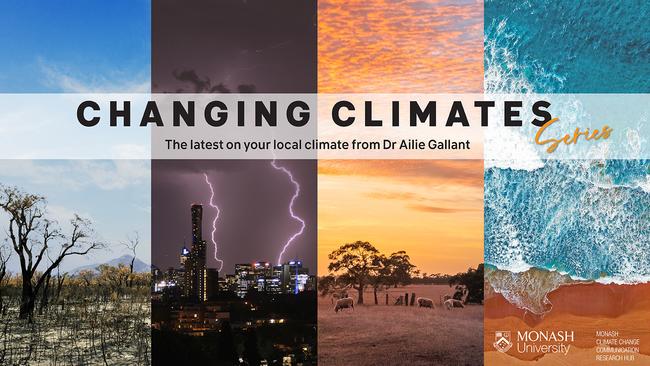Supermarket shelves feeling the heat of climate change
Climate change is drying up bargains on our supermarket shelves. Host of the inner east's Changing Climates series, Dr Ailie Gallant, explains why.

HyperLocal
Don't miss out on the headlines from HyperLocal. Followed categories will be added to My News.
If you think you've been paying more for everyday items recently, your gut feeling is right on the money.
In December last year, the Australian Bureau of Statistics reported that groceries were costing Aussies around 4.5 per cent more than the year before.
This increase in food prices outpaced the rate of inflation, leaving Aussies to bear the brunt of high grocery costs.
A recent inquiry led by a former chair of the Australian Consumer and Competition Commission, Professor Allan Fels, found a lack of market competition has led to higher grocery bills at our leading supermarket chains.
Unlike Britain and the US where the top two supermarkets have a combined market share of 43 per cent and 32 per cent respectively, Coles and Woolworths control over 60 per cent of Australia's grocery retail market.
However, Australia's two-player market isn't the only factor driving up food prices.
Climate change is another chief culprit.
Rising greenhouse gas emissions mean we are now experiencing higher temperatures and an increase in the frequency and intensity of extreme weather events like heatwaves, bushfires, droughts and floods.
For example, the inner east now experiences almost eight more March days above 20C compared to the early 1970s.
These higher temperatures and extremes have major implications for our farmers and our grocery bills.

Farming on the frontline
For many of us, bringing food into our home involves zooming a trolley around, searching for yellow specials tickets, and tapping our cards at the checkout.
But the journey food takes to our kitchens starts much earlier – with our farmers.
Agriculture contributes billions of dollars to our economy and sits at the heart of many rural and regional communities.
However, our farms and the food they provide are extremely sensitive to changes in the climate, needing just the right set of conditions to flourish.
And as more emissions are pumped into the atmosphere these prime conditions will likely become harder to find.
In fact, we only need to look back at 2023 to find the hottest yearin recorded history.
We also saw the driest September since Australian records began over 100 years ago.
As our climate continues to warm, thechanging seasonsmake it more difficult for our farmers to plan ahead and ensure crops and livestock are protected
We've seen the implications of this on several of our pantry staples already.
Over the past year, the price of bread and other cereal products rose by around 7.5 per cent as wheat production shrivelled under dry conditions.
Fruit and veg hasn't escaped the price creep either, with $12 lettuces hitting the shelves in the winter of 2022 after major flooding across south-east Queensland.
Increasingly challenging growing conditions for our crops will likely decrease yield and continue to drive up prices on our supermarket shelves.
Making ends meet
Rising food prices impact everyone, but some of us are in a better position to weather the storm than others.
While rising food prices impact everyone, some of us are in a better position to weather the storm than others.3.7 million Aussie households have experienced food insecurity in the last 12 months – that's more than the number of households in Sydney and Melbourne combined!
Over 75 per cent of those households were experiencing food insecurity for the first time.
Why such a rise?
According to Foodbank, this is because food is the most likely thing to be sacrificed to make ends meet.
And with costs ballooning across the board, skipping a meal is a simple way to save dollars and keep the lights on.
Rising food prices don't just affect our wallets, they also have short and long-term impacts on our health and wellbeing.
For example, food insecurity has been shown to cause stress, cycles of fasting and bingeing, and substituting expensive, nutritional food with cheaper, less nutritious food.
Food cost and availability also varies across the country, with Ausses living remote typically paying higher prices for lower quality food which is more likely to make them sick.
Long term, all these impacts put vulnerable households at risk of having to shell out more for healthcare.
Solutions in store
Rising food prices might be hard to stomach, but there are some ways we can help make grocery shopping a little more palatable.
Visiting your local farmers market is a great way to get fresh, seasonal produce at reasonable prices while also putting dollars directly in the pockets of our farmers.
Another option is to take farming into your own hands, and plant some fruit and veg in the backyard or get involved in a community garden.
Apartment dwellers can get in on the action too by creating small, but thriving balcony gardens full of essential ingredients – think tomatoes, chillies and plenty of herbs.
More broadly, driving down emissions is the best way we can keep enjoying our favourite foods at an affordable price.
So the next time you're off to the shops, leave the care at home and opt for a stroll, train, or bike ride and cut back on emissions and costs before you even step in the store.
By looking after our planet we can collectively tackle the cost-of-eating crisis and put bargains back on our supermarket shelves.
It's quiz time
Want more information on how your climate is changing? Check out the last article in this series.
Dr Ailie Gallant is a climate scientist and senior lecturer at Monash University.
This column is part of a collaboration between Monash University and News Corp to deliver hyperlocal weather and climate information.


